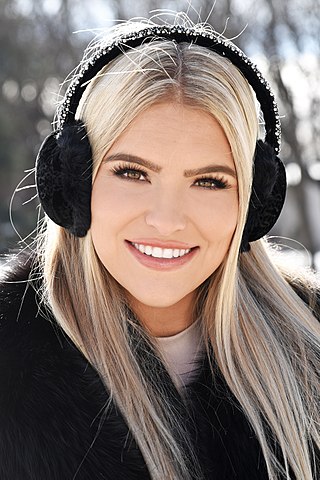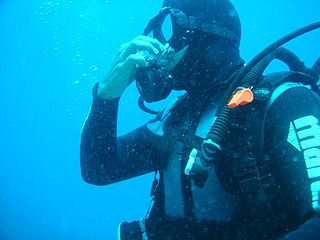Ear protection may pertain to protecting the ear from cold, intrusion by water or debris, or noise. It may refer to:
Ear protection may pertain to protecting the ear from cold, intrusion by water or debris, or noise. It may refer to:
A pet is an animal kept primarily for company, protection or entertainment.
Appliance may refer to:

Active noise control (ANC), also known as noise cancellation (NC), or active noise reduction (ANR), is a method for reducing unwanted sound by the addition of a second sound specifically designed to cancel the first. The concept was first developed in the late 1930s; later developmental work that began in the 1950s eventually resulted in commercial airline headsets with the technology becoming available in the late 1980s. The technology is also used in road vehicles, mobile telephones, earbuds, and headphones.

Barotrauma is physical damage to body tissues caused by a difference in pressure between a gas space inside, or in contact with, the body and the surrounding gas or liquid. The initial damage is usually due to over-stretching the tissues in tension or shear, either directly by an expansion of the gas in the closed space or by pressure difference hydrostatically transmitted through the tissue. Tissue rupture may be complicated by the introduction of gas into the local tissue or circulation through the initial trauma site, which can cause blockage of circulation at distant sites or interfere with the normal function of an organ by its presence. The term is usually applied when the gas volume involved already exists prior to decompression. Barotrama can occur during both compression and decompression events.

The axial skeleton is the part of the skeleton that consists of the bones of the head and trunk of a vertebrate. In the human skeleton, it consists of 80 bones and is composed of six parts; the skull, also the ossicles of the middle ear, the hyoid bone, the rib cage, sternum and the vertebral column. The axial skeleton together with the appendicular skeleton form the complete skeleton. Another definition of axial skeleton is the bones including the vertebrae, sacrum, coccyx, skull, ribs, and sternum.

An ushanka, also called an ushanka-hat, is a Russian fur hat with ear-covering flaps that can be tied up on the crown of the cap, or fastened at the chin to protect the ears, jaw, and lower chin from the cold. An alternative way to wear is to bend the flaps back and tie them behind the head, which is called "ski-style" — this offers less protection from the elements, but much better visibility, essential for high-speed skiing. The dense fur also offers some protection against blunt impacts to the head. They are also traditionally worn in the Baltic region including Sweden, Finland, Norway and the whole eastern European region.

Docking is the removal of portions of an animal's tail. While docking and bobbing are more commonly used to refer to removal of the tail, the term cropping is used in reference to the ears. Tail docking occurs in one of two ways. The first involves constricting the blood supply to the tail with a rubber ligature for a few days until the tail falls off. The second involves the severance of the tail with surgical scissors or a scalpel. The length to which tails are docked varies by breed, and is often specified in the breed standard.

An ear is the organ that enables hearing and body balance using the vestibular system. In mammals, the ear is usually described as having three parts: the outer ear, the middle ear and the inner ear. The outer ear consists of the pinna and the ear canal. Since the outer ear is the only visible portion of the ear in most animals, the word "ear" often refers to the external part alone. The middle ear includes the tympanic cavity and the three ossicles. The inner ear sits in the bony labyrinth, and contains structures which are key to several senses: the semicircular canals, which enable balance and eye tracking when moving; the utricle and saccule, which enable balance when stationary; and the cochlea, which enables hearing. The ear is a self cleaning organ through its relationship with earwax and the ear canals. The ears of vertebrates are placed somewhat symmetrically on either side of the head, an arrangement that aids sound localization.

An earplug is a device that is inserted in the ear canal to protect the user's ears from loud noises, intrusion of water, foreign bodies, dust or excessive wind. Since they reduce the sound volume, earplugs may prevent hearing loss and tinnitus, in some causes.

Earmuffs are clothing accessories or personal protective equipment designed to cover a person's ears for hearing protection or warmth. They consist of a thermoplastic or metal head-band that fits over the top or back of the head, and a cushion or cup at each end to cover the ears.

A headband or hairband is a clothing accessory worn in the hair or around the forehead, usually to hold hair away from the face or eyes. Headbands generally consist of a loop of elastic material or a horseshoe-shaped piece of flexible plastic or metal. They come in assorted shapes and sizes and are used for both fashion and practical or utilitarian purposes.

Wood-ear or tree ear, also translated wood jellyfish or tree jellyfish, can refer to a few similar-looking edible fungi used primarily in Chinese cuisine; these are commonly sold in Asian markets shredded and dried.

Noise-induced hearing loss (NIHL) is a hearing impairment resulting from exposure to loud sound. People may have a loss of perception of a narrow range of frequencies or impaired perception of sound including sensitivity to sound or ringing in the ears. When exposure to hazards such as noise occur at work and is associated with hearing loss, it is referred to as occupational hearing loss.

Rhett James McLaughlin and Charles Lincoln "Link" Neal III are an American comedy duo. Self-styled as "Internetainers", they are known for creating and hosting the YouTube series Good Mythical Morning. Their other notable projects include comedic songs and sketches, their IFC series Rhett & Link: Commercial Kings, their YouTube Premium series Rhett & Link's Buddy System, their podcast Ear Biscuits and their novel The Lost Causes of Bleak Creek.

Ear clearing or clearing the ears or equalization is any of various maneuvers to equalize the pressure in the middle ear with the outside pressure, by letting air enter along the Eustachian tubes, as this does not always happen automatically when the pressure in the middle ear is lower than the outside pressure. This need can arise in scuba diving, freediving/spearfishing, skydiving, fast descent in an aircraft, fast descent in a mine cage, and being put into pressure in a caisson or similar internally pressurised enclosure, or sometimes even simply travelling at fast speeds in an automobile.

Cropping is the removal of part or all of the external flaps of an animal's ear. The procedure sometimes involves bracing and taping the remainder of the ears to train them to point upright. Almost exclusively performed on dogs, it is an old practice that was once done for perceived health, practical or cosmetic reasons. Veterinary science states there is no medical or physical advantage to the animal from the procedure, leading to concerns of animal cruelty over performing unnecessary surgery on animals. In modern times, cropping is banned in many nations, but is still legal in a limited number of countries. Where permitted, it is seen only in certain breeds of dog, such as pit bull and bull terrier type breeds, the Doberman Pinscher, Schnauzer, Great Dane, Boxer and Cane Corso.

An orillon, also known as an orillion, is an architectural element of a military fortification. The ear-shaped projection of masonry provided defense for guns and soldiers at the flank of a bastion. However, an orillon could also shield a city gate.

Bears Ears National Monument is a United States national monument located in San Juan County in southeastern Utah, established by President Barack Obama by presidential proclamation on December 28, 2016. The monument protects 1,351,849 acres of public land surrounding the Bears Ears—a pair of buttes—and the Indian Creek corridor rock climbing area. The Native American names for the buttes have the same meaning in each of the languages represented in the region. The names are listed in the presidential proclamation as "Hoon’Naqvut, Shash Jáa [sic], Kwiyaghatʉ Nükavachi/Kwiyagatu Nukavachi, Ansh An Lashokdiwe"—all four mean "Bears Ears".

A hearing protection device, also known as a HPD, is an ear protection device worn in or over the ears while exposed to hazardous noise and provide hearing protection to help prevent noise-induced hearing loss. HPDs reduce the level of the noise entering the ear. HPDs can also protect against other effects of noise exposure such as tinnitus and hyperacusis. There are many different types of HPDs available for use, including earmuffs, earplugs, electronic hearing protection devices, and semi-insert devices.

Hearing protector fit-testing measures the degree of noise reduction obtained from an individual wearing a particular hearing protection device (HPD) - for example, an earplug or earmuff. Such measurements are necessary because noise attenuation varies across individuals due to anatomical differences and inadequate training as to the proper wear and use. Labeled HPD attenuation values are average values that cannot predict noise attenuation for an individual; in addition, they are based on laboratory measurements which may overestimate the noise reduction obtained in the real world.